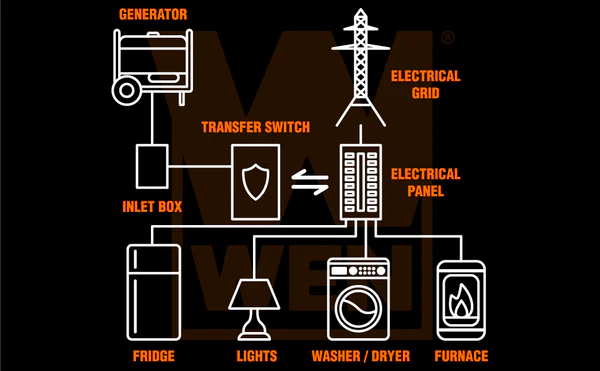Electrical issues can feel intimidating, but many of the questions we hear have simple explanations. Here's a quick guide to some of the most common concerns we hear from local homeowners.
When it comes to ensuring your home’s electrical system is ready for unexpected power outages, a generator transfer switch is an essential component. It allows you to safely and efficiently switch your home’s power source from the grid to your generator. Here’s a comprehensive guide to help you choose the right transfer switch for your needs.
1. Types of Transfer Switches
There are two main types of transfer switches: manual and automatic.
- Manual Transfer Switch: These are used with portable generators. Requires you to manually switch the power source from the grid to the generator. These are typically less expensive and simpler to install.
- Automatic Transfer Switch (ATS): These are used with stand-by generators. Automatically detects a power outage and switches to the generator power. These are more convenient but usually more expensive.
2. Assess Your Power Requirements
Determine the total wattage of the appliances and systems you plan to power with the generator. The transfer switch should be able to handle the combined load. Check the amperage rating of the transfer switch to ensure it matches your generator and home’s electrical system.
3. Ensure Compatibility with Your Generator
Ensure the transfer switch is compatible with your specific generator model. Some switches are designed for particular brands or models. Verify the voltage compatibility (120V, 240V, or both) between the generator and the transfer switch.
4. Number of Circuits
Choose a transfer switch that has enough circuits to cover your essential appliances and systems. Common options are 6-circuit, 10-circuit, and 12-circuit switches. Consider future expansion needs – it might be worth getting a switch with more circuits than you currently need.
5. Installation Requirements
Assess whether the transfer switch can be installed indoors or outdoors, depending on your setup. It is generally recommended that it be installed outdoors so that the generator can be placed a safe distance from the home. Determine if you need professional installation or if you can handle the installation yourself. An electrician may be required for more complex installations.
6. Safety Features
Look for switches with built-in safety features, such as overload protection and automatic shutdown in case of a fault. Ensure the transfer switch complies with local electrical codes and standards, such as UL 1008 certification, which ensures rigorous safety standards are met.
7. Ease of Use
Consider the user interface of the switch. For manual switches, look for easy-to-read labels and straightforward operation. For ATS, check if it has a user-friendly control panel and clear indicators for operation status.
8. Price and Warranty
Compare prices from different brands and models to find a switch that fits your budget without compromising on quality. Check the warranty and support options provided by the manufacturer. A good warranty can offer peace of mind and protection for your investment.
9. Brand Reputation
Research reviews and ratings of different brands and models. A reputable brand with positive feedback from other users is often a safer choice. Look for customer service and technical support availability from the manufacturer.
10. Electrical Permits
Before your generator transfer switch installation, make sure to obtain the necessary Hillsborough County electrical permits. These permits are essential to guarantee compliance with National Electrical Codes and ensure the work is carried out safely. Following the completion of your project, Hillsborough County mandates a thorough county inspection to verify everything meets the required standards.
11. Additional Features to Consider
Here are some extra features that can enhance the functionality and convenience of your transfer switch:
- Onboard Power Meters: These meters will tell you, in real time, how much power is being consumed. This is important for load balancing, ensuring you don’t overload your generator.
- Tie Bars: Used to convert two single-pole breakers (usually used with 120-volt circuits) to one double-pole breaker (usually used with 240-volt circuits). If you don’t plan to power anything connected to a 240-volt circuit, you probably don’t need this feature.
- Weather-Resistant or Weatherproof Inlet Box: Make sure the inlet box used with your transfer switch is capable of handling the rigors of outdoor use. Look for enclosures with NEMA 3R (weather-resistant), 4 (weatherproof), or 4X (weatherproof and corrosion resistant) ratings. If you live in a coastal area with lots of salt air or salt spray, consider one with a 4X rating.
- Long Extension Cord: Ideally, this will be at least 20 feet. Generators must only be used outdoors, at least 20 feet away from the home, as well as away from doors and windows, to reduce the chance of carbon monoxide (CO) entering the home. Make sure the extension cord uses the correct plug and receptacle type (usually, it’s a 30-amp NEMA L14-30) to mate with your generator’s outlet and the inlet box. Also, ensure the cord is the right gauge to handle the loads that will be required of it.
Conclusion
Selecting the right generator transfer switch involves balancing your power needs, budget, and preferences for convenience and safety. By considering the factors and features outlined above, you can make an informed decision that ensures reliable and safe power transfer during outages. Investing in a quality transfer switch will provide peace of mind and keep your essential appliances running smoothly when the grid goes down.
For more tips and expert advice on preparing your home electrical systems, stay tuned to our blog!




